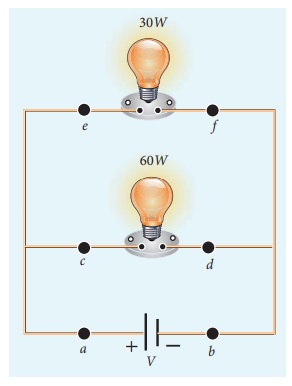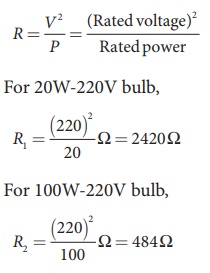Chapter: 12th Physics : Current Electricity
Energy and Power in Electrical Circuits: Solved Example Problems
Energy and Power in Electrical Circuits: Solved Example Problems
EXAMPLE 2.15
A battery of voltage V is connected to 30 W bulb and 60 W bulb as shown in the figure. (a) Identify brightest bulb (b) which bulb has greater resistance? (c) Suppose the two bulbs are connected in series, which bulb will glow brighter?

Solution
(a) The power delivered by the battery P = VI. Since the bulbs are connected in parallel, the voltage drop across each bulb is the same. If the voltage is kept fixed, then the power is directly proportional to current (P ŌłØ I). So 60 W bulb draws twice as much as current as 30 W and it will glow brighter then others.
(b) To calculate the resistance of the bulbs, we use the relation P = V2 / R . In both the bulbs, the voltage drop is the same, so the power is inversely proportional to the resistance or resistance is inversely proportional to the power (RŌłØ1/P) . It implies that, the 30W has twice as much as resistance as 60 W bulb.
(c) When these two bulbs are connected in series, the current passing through each bulb is the same. It is equivalent to two resistors connected in series. The bulb which has higher resistance has higher voltage drop. So 30W bulb will glow brighter than 60W bulb. So the higher power rating does not always imply more brightness and it depends whether bulbs are connected in series or parallel.
EXAMPLE 2.16
Two electric bulbs marked 20 W ŌĆō 220 V and 100 W ŌĆō 220 V are connected in series to 440 V supply. Which bulb will be fused?
Solution
To check which bulb will be fused, the voltage drop across each bulb has to be calculated.
The resistance of a bulb,

Both the bulbs are connected in series. So the current which passes through both the bulbs are same. The current that passes through the circuit, I = V /Rtot.
Rtot = ( R1 + R2 )
Rtot = ( 484 +2420) ╬® = 2904╬®
I = 440V/2904╬® Ōēł 0.151A
The voltage drop across the 20W bulb is
V1 = IR1 = 440/2904 ├Ś 2420 Ōēł 366.6 V
The voltage drop across the 100W bulb is
V2 = IR2 = 440/2904 ├Ś 484 Ōēł 73.3 V
The 20 W bulb will be fused because its voltage rating is only 220 V and 366.6 V is dropped across it.
Related Topics